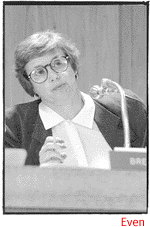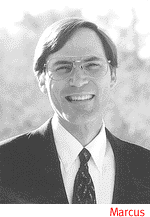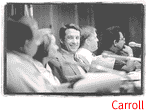
...And They Crowd Pima County's District 4 Special Republican Primary. Here Are The Candidates And The Issues.
By Chris Limberis
WHEN IT COMES to transportation hereabouts, there's much
to be done. And nowhere near the money to do it.
But how we'll get from here to there and at what speed may depend
in part on whether Ray Carroll, Brenda Even or Ken Marcus wins
Pima County's District 4 special Republican primary election on
September 8.
There are general issues: Pima County transportation needs through
the next 22 years that exceed $9 billion; the heavily subsidized
and troubled SunTran bus system, where a change in direction can
leave riders with a two-hour commute; Greater Tucson's increasingly
congested east-west thoroughfares; and all those clogged northwest-side
roads.
 And there are specifics for District 4, which covers Tucson's
eastside and Green Valley: the crossing of Sabino Creek at Snyder
Road; the west parkway and other improvements in Green Valley;
assorted widenings and improvements on 18 stretches of county
roadways.
And there are specifics for District 4, which covers Tucson's
eastside and Green Valley: the crossing of Sabino Creek at Snyder
Road; the west parkway and other improvements in Green Valley;
assorted widenings and improvements on 18 stretches of county
roadways.
District 4 made out fairly well when the capital-improvement
pie was cut up earlier this year, after the county's successful
$350-million transportation bond election. Active projects in
District 4 total nearly $80 million. Add another $38.9 million
for future projection, including a $20 million improvement on
Houghton Road running south from Speedway, and District 4 will
drive on $118 million worth of asphalt and concrete.
Carroll is hoping to retain the seat he was appointed to last
year when Even's husband, John, died of cancer just four months
into his term. Carroll was the self-described "poster boy''
for the 1997 road bonds. He made the breakfast and rubber-chicken
circuit, did the media and cajoled other supervisors and members
of the City Council to get a package adopted and then approved
by voters.
The vote was historic, and not just because it was the first
road question voters had approved in Pima County in 11 years,
but because the bonds will be repaid for the first time with gas
taxes. This type of revenue bond helped keep the county from loading
even more taxes on overburdened property owners.
Property owners have felt that bite for 24 years. Indeed, since
they approved $7.2 million in bonds for streets and bridges in
1974, voters have given the county permission to sink $212 million
in debt for road financing. That amount on the property taxes
is almost nine times higher than the combined general obligation
debt the other 14 Arizona counties have placed on voters for transportation
improvements since 1975.
Carroll, an agent for Grubb & Ellis Commercial Real Estate
before being appointed last year, followed John Even's example
on the transportation bond development and promotion. John Even,
who had helped Pima Community College officials engineer a victorious
bond election of their own, worked hard to develop the county's
bond proposal and its truth-in-bonding law.
All the more surprising, then, is Brenda Even's call for "creative"
solutions to transportation problems that include a revival of
the Rillito-Pantano Parkway. Voters smashed the idea in 1984.
Marcus, an accountant and finance manager for Bell & Howell's
waning Tucson office, wants to devote more resources to taking
care of existing roads.
Here's a more detailed breakdown of transportation positions
among District 4 candidates:
Snyder Road
ONE OF THE smallest sections of road--and a bridge, in
this case--generates at various times the most heat. County officials,
ranging from road men and transportation technocrats to cops,
have wanted a crossing on Sabino Creek, the last of the perennial
Tucson streams. They, along with developers, cite complaints from
Tucson Unified School District (because of the long schlep those
poor Sabino High students had to make) and emergency-service providers.
Each time the idea is floated, or added to a map, such as in the
failed 1986 Regional Transportation Plan, environmentalists and
neighbors rise with fury.
But developers and promoters of Sabino Springs, the upscale subdivision
with the exclusive Raven golf course, revived the push again this
spring. Timidity overran the Board of Supervisors and the issue
of a bridge, with a price tag that fluctuates between $8 million
and $25 million, never made it onto an agenda.
 Carroll instead appointed a six-member committee that, unlike
previous efforts, has the benefit of technical assistance from
county transportation officials.
Carroll instead appointed a six-member committee that, unlike
previous efforts, has the benefit of technical assistance from
county transportation officials.
"There is no money for a bridge," Carroll says. "It's
not in the bond, but because this issue keeps coming up every
few years, I set up this neighborhood committee to try to reach
a fact-intensive solution."
There are members from each side--of the creek and the issue.
Marcus didn't take Carroll's bait when the supervisor wanted Marcus
on the panel.
"I said that it was political already and that I didn't
want to add to that," Marcus says. "I gave them the
names of others in the neighborhood who were knowledgeable."
Marcus says there are a variety of reasons why the bridge shouldn't
be built:
"Special interests are pushing it. They want more rounds
of golf at Raven. It would be a bridge to nowhere, people would
still have to use Sabino Canyon Road or Bear Canyon. It would
open up the Tanque Verde Valley to development, and it's in a
poor place. Two creeks come together there. Sabino Creek is one
of the jewels of the community. It seems like it would be just
a short-term fix that would ruin the environment and destroy a
neighborhood."
Even, who has sat on the TUSD board for eight years, has no clear
position on the bridge.
"Certainly there are pros and cons," Even says. "We
need to look at options. I've heard this has changed to a covered
bridge (slow-drive) type. Unless it's a sufficient bridge, there
will be more congestion."
Moving It Along
MARCUS WANTS TO move traffic by doing a better job of maintaining
existing roads. Many roads in District 4, he says, are deteriorating,
and the improvements underway or planned represent a "real
checkerboard" that does not sustain momentum.
Marcus was first to remind District 4 voters of Los Angeles'
move to stagger work schedules during the 1984 Olympics.
"It worked," Marcus frequently says on the stump. "And
then they forgot."
Even has since appropriated the suggestion, to Marcus' mild amusement.
"She took off with it. It's a good idea," he says.
Marcus also wants to press the transportation section of the
Pima Association of Governments for more development of "smart"
traffic solutions through technology. Light timing is perhaps
the most obvious of such solutions.
Light rail, another of Tucson' on-off planning items, won't work,
Marcus says, because housing densities here, ranging from 2,500
to 5,000 per square mile, are too low.
"They need to be 20,000 to 25,000 per square mile for it
to work because it's so expensive," Marcus says.
Bus ridership must be increased, says Marcus, who adds he once
lost two hours trying to get from his northeast side home to his
southside office on SunTran.
 "If you have to change direction, forget it," Marcus
says.
"If you have to change direction, forget it," Marcus
says.
While Marcus notes the heavy subsidy the city pours into SunTran--more
than 75 percent of its budget--Carroll asks: "Why don't we
just make it free?"
"Let's get people in our buses. It would help with getting
the old junkers off the road," Carroll says.
Carroll also wants to beef up service during winter snowbird
season with special tour buses.
Carroll says District 4 should be pleased with the projects it
got out of last year's bond election, which, incidentally, failed
in Green Valley.
He ties transportation congestion to other county problems:
"Road rage is an obvious problem," Carroll says. "The
more cops we have responding to fender benders, the less time
they are out solving crimes. Cops should be with criminals, not
settling fender benders."
Carroll chides Tucson Mayor George Miller's quest for underpasses
at congested intersections, saying the second-term Democrat forgets
the city's Neighborhood Protection Amendment, which requires a
vote on major road projects. But when Carroll calls for connection
of Sabino Canyon and Kolb roads, he laments: "A lot of time,
the control of transportation has been lost to neighborhoods."
Carroll blames transportation problems on "unchecked growth''
that has robbed the county of enough money to help drivers have
a "safe and easier commute."
Carroll has worked on other ventures, including a shuttle up
Mount Lemmon. The plan is still in the early phases. A private
company would be sought to operate the shuttle.
Even talks most about finding an east-west parkway on the northside
that would be similar to the Aviation Parkway.
Her calls for "creativity" include such proposals as
a new Rillito-Pantano Parkway. Astoundingly, she boasted of this
in May in front of a Neighborhood Coalition of Greater Tucson
crowd--folks who popularized the "Keep it Kinky" campaign
to kill the Rillito-Pantano in 1984.
Throughout her campaign, Even has called for study and examination,
offering very little in the way of definitive plans.
She supports grade-separated intersections, such as the Tanque
Verde-Wrightstown overpass near her home.
Funding
THOSE OVERPASS-underpass plans helped propel voters to
kill a countywide, half-cent sales tax proposal by 61 percent
to 39 percent in 1990. Four years earlier, a half-cent sales tax
for transportation improvements failed 57 percent to 43 percent.
And a quarter-cent sales tax for jails and a juvenile detention
facility and court failed by 70 percent to 30 percent in 1994.
There is no Pima County sales tax. Consumers pay 5 cents in state
sales tax, of which Pima County gets a share. Tucson and the other
area municipalities levy a 2 percent sales tax.
Even says she favors an increased gas tax to help make up the
difference in what is needed and what the county will rake in
as its increased share of state gas taxes.
 "It's most closely tied to the use," Even says.
"It's most closely tied to the use," Even says.
Marcus is leery of any new tax.
"There is talk of a quarter-cent sales tax," Marcus
says. "The sheriff is calling for a half-cent sales tax,
and the open-space people are calling for another half-cent sales
tax. I think people are taxed out."
Gas taxes, Marcus says, have a "ripple effect" on the
economy that could be negative. And impact fees on new houses,
now at $1,550 each, should be staggered to slide with the actual
impact each development has. Proximity to sewer, water and roads,
and the necessity for extending these and other services, would
be key to levying a higher fee, Marcus says.
Now seeking voter approval to fill the rest of John Even's term
(to 2000), Carroll can't afford to call for a new tax. But in
a GOP forum on July 18, Carroll spoke highly of a sales tax as
a way to shift revenue and cut property taxes.
Carroll also believes the county can raise cash for transportation
needs through the sale of county assets, particularly surplus
residential properties the county currently oversees as a landlord.

|





